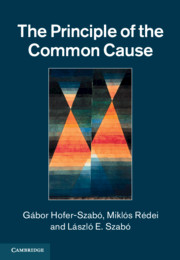Book contents
- Frontmatter
- Contents
- Preface
- 1 Introduction and overview
- 2 The Common Cause Principle
- 3 Common cause extendability of probability spaces
- 4 Causally closed probability theories
- 5 Common common causes
- 6 Common cause extendability of nonclassical probability spaces
- 7 Reichenbachian common cause systems
- 8 Causal closedness of quantum field theory
- 9 Reichenbach's Common Cause Principle and EPR correlations
- 10 Where do we stand?
- Appendix
- References
- Index
8 - Causal closedness of quantum field theory
Published online by Cambridge University Press: 05 June 2013
- Frontmatter
- Contents
- Preface
- 1 Introduction and overview
- 2 The Common Cause Principle
- 3 Common cause extendability of probability spaces
- 4 Causally closed probability theories
- 5 Common common causes
- 6 Common cause extendability of nonclassical probability spaces
- 7 Reichenbachian common cause systems
- 8 Causal closedness of quantum field theory
- 9 Reichenbach's Common Cause Principle and EPR correlations
- 10 Where do we stand?
- Appendix
- References
- Index
Summary
The Common Cause Principle in algebraic relativistic quantum field theory
Algebraic quantum field theory (AQFT) predicts correlations between projections A, B lying in von Neumann algebras A(V1), A(V2) associated with spacelike separated spacetime regions V1, V2 in Minkowski spacetime. These spacelike correlations predicted by AQFT lead naturally to the question of the status of Reichenbach's Common Cause Principle within AQFT. The aim of this chapter is to investigate the problem of status of Reichenbach's Common Cause Principle within AQFT.
Since the correlated projections belong to algebras associated with spacelike separated regions, a direct causal influence between them is excluded by the Special Theory of Relativity. Consequently, compliance of AQFT with Reichenbach's Common Cause Principle would mean that for every correlation between projections A and B lying in von Neumann algebras A(V1) and A(V2), respectively, associated with spacelike separated spacetime regions V1, V2, there must exist a projection C possessing the probabilistic properties that qualify it to be a Reichenbachian common cause of the correlation between A and B. However, since observables and hence also the projections in AQFT must be localized, one also has to specify the spacetime region V with which the von Neumann algebra A(V) is associated that contains the common cause C.
Intuitively, the region V should be disjoint from both V1 and V2 but should not be causally disjoint from them in order to leave room for a causal effect of C on the events A and B so that C can account for the correlation between A and B.
- Type
- Chapter
- Information
- The Principle of the Common Cause , pp. 97 - 133Publisher: Cambridge University PressPrint publication year: 2013



